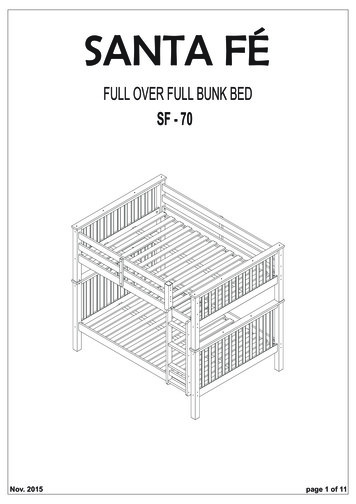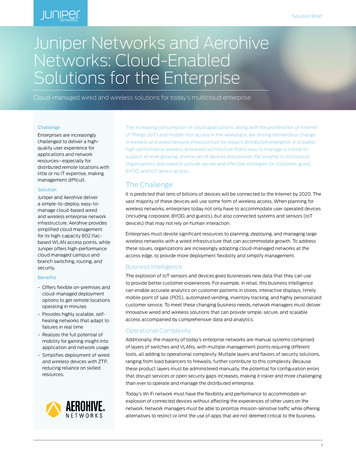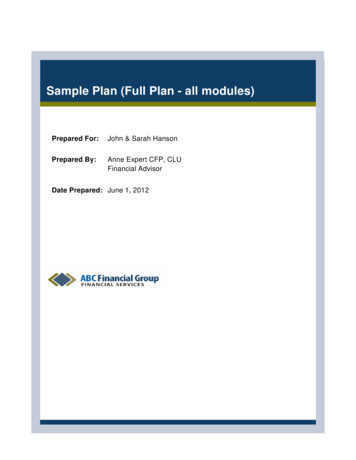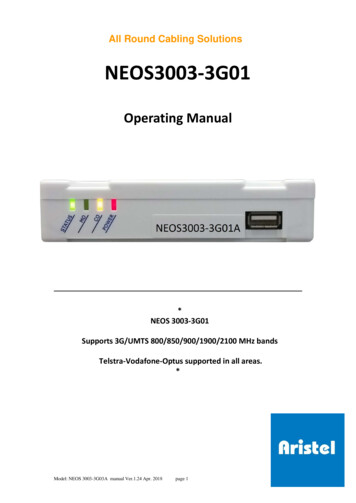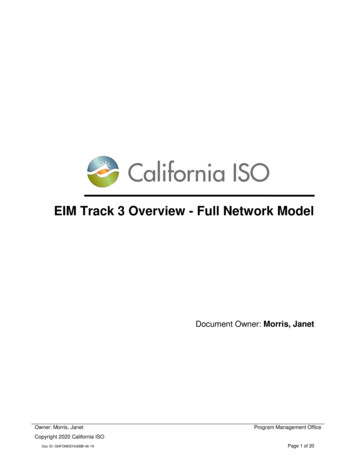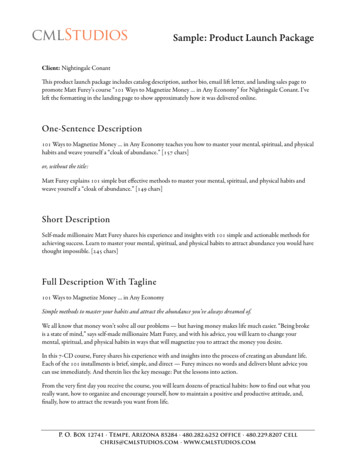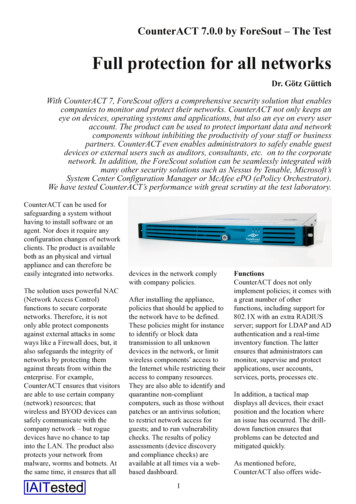
Transcription
CounterACT 7.0.0 by ForeSout – The TestFull protection for all networksDr. Götz GüttichWith CounterACT 7, ForeScout offers a comprehensive security solution that enablescompanies to monitor and protect their networks. CounterACT not only keeps aneye on devices, operating systems and applications, but also an eye on every useraccount. The product can be used to protect important data and networkcomponents without inhibiting the productivity of your staff or businesspartners. CounterACT even enables administrators to safely enable guestdevices or external users such as auditors, consultants, etc. on to the corporatenetwork. In addition, the ForeScout solution can be seamlessly integrated withmany other security solutions such as Nessus by Tenable, Microsoft’sSystem Center Configuration Manager or McAfee ePO (ePolicy Orchestrator).We have tested CounterACT’s performance with great scrutiny at the test laboratory.CounterACT can be used forsafeguarding a system withouthaving to install software or anagent. Nor does it require anyconfiguration changes of networkclients. The product is availableboth as an physical and virtualappliance and can therefore beeasily integrated into networks.The solution uses powerful NAC(Network Access Control)functions to secure corporatenetworks. Therefore, it is notonly able protect componentsagainst external attacks in someways like a Firewall does, but, italso safeguards the integrity ofnetworks by protecting themagainst threats from within theenterprise. For example,CounterACT ensures that visitorsare able to use certain company(network) resources; thatwireless and BYOD devices cansafely communicate with thecompany network – but roguedevices have no chance to tapinto the LAN. The product alsoprotects your network frommalware, worms and botnets. Atthe same time, it ensures that alldevices in the network complywith company policies.After installing the appliance,policies that should be applied tothe network have to be defined.These policies might for instanceto identify or block datatransmission to all unknowndevices in the network, or limitwireless components’ access tothe Internet while restricting theiraccess to company resources.They are also able to identify andquarantine non compliantcomputers, such as those withoutpatches or an antivirus solution;to restrict network access forguests; and to run vulnerabilitychecks. The results of policyassessments (device discoveryand compliance checks) areavailable at all times via a web based dashboard.1FunctionsCounterACT does not onlyimplement policies; it comes witha great number of otherfunctions, including support for802.1X with an extra RADIUSserver; support for LDAP and ADauthentication and a real timeinventory function. The latterensures that administrators canmonitor, supervise and protectapplications, user accounts,services, ports, processes etc.In addition, a tactical mapdisplays all devices, their exactposition and the location wherean issue has occurred. The drill down function ensures thatproblems can be detected andmitigated quickly.As mentioned before,CounterACT also offers wide
ranging endpoint compliancefunctionalities. Those enable IT staff to ensure overallcompliance with configurationstandards (such as antivirus andpatch policies) throughout thenetwork; that personal firewallswork (are installed and active)and that no unauthorisedapplications are running onsystems.If a computer does not complywith company policiesCounterACT informs theAs soon as CounterACT has beeninstalled it first updates themanagement tooladministrators of the user, thedevice’s location and the problemidentified by the solution.Thanks to close monitoring ofusers and their devices, thesystem can identify users whoare running Peer to Peer Software (P2P), or engage in anyother undesired activities. UsingCounterACT, the IT departmentmay send a warning to theseusers, restrict their data accessvia a virtual firewall, or kickthem out of the network. Theproduct also protects systemsagainst hackers by offering abehaviour based IPS withhoneypot features.The solution is also availablewith high availabilityconfiguration, thereby ensuringthat network protection canremain active even in case of ahardware failure. According tothe manufacturer, CounterACTdelivers a good performanceeven in very large environmentswith more than 500,000endpoints. There are severalmodels available which aresuitable for environments of allsizes.The TestWe tested the CounterACTappliance by deploying it into ournetwork. The correspondingmanagement tool, theCounterACT console, wasinstalled on an administratorwork station. We let the solutioncollect data about ourenvironment and defined policiesto ensure that all our componentsare working properly. Thisincluded policies for theclassification of existing systems,for compliance and handlingmalicious hosts. Policy violationswere eliminated with the help ofremediation actions.The next step was testing guestmanagement. In addition, weanalysed the way CounterACTwas protecting the network fromrogues. Then we tested featuresfor BYOD (Bring Your OwnDevice) and MDM (MobileDevice Management), as well asCounterACT’s interoperabilitywith third party solutions. Weused Nessus by Tenable,McAfee’s ePO and WSUS byMicrosoft for this test.InstallationThe CounterACT appliancenormally operates with threedifferent interfaces: Themanagement interface is used formanaging the solution. The2monitoring interface monitorsnetwork information and traffic,while the response interfacetransmits information to takeaction from corporate network incase of security problems, forinstance by blocking rogueDHCP servers or interruptingdata transmission.We tested the solution in ournetwork on a monitoring port of aCisco Switch (SPAN. For theresponse port we used a VLANtrunk on the same switch. Manyother configurations are alsopossible as described in detail inthe product documentation. Forexample response andmanagement ports can be merged(layer 3 installation) in smallerenvironments.After connecting the appliance,we assigned an IP address via thelocal console and set theadministrator password. Then weaccessed the appliance from themanagement client via the URLhttp://{IP address of theappliance}/install to downloadthe installation file with themanagement software. Setting upthe product was fairly easy fromthis point on. Installationbasically only requires one outputpath. As soon as the output pathis chosen, setup is doneautomatically and the console canbe used immediately.First LoginAt opening the managementconsole, we could log on to theappliance with the IP address andadministrator credentials. Theinstallation wizard startedautomatically, asking for themain parameters required to startthe system. This includes forinstance setting the user directoryfor network authentications and
correlate user details. In additionto the Active Directory used inour test, the ForeScout solutionalso supports Sun Java SystemDirectory, IBM Notes, LDAP,Novell ‘s eDirectory, as well asRADIUS and TACACS systems.The assistant then asks fordomain credentials, which ensurethat the ForeScout appliance canclosely monitor the networkhosts (without the use of agents).Under “authentication servers”additional authentication systems– such as exchange servers – canbe added to the network. Thedefine the internal network and toconfigure CounterACT switchplug in that the system uses tomonitor and adjust switchconfiguration in the network.The last dialogue box in thewizard is called “inventory”. It isused to display network assetsand activities (for exampleprocess and services) of logged in users and devices in real timewithin in the managementconsole. This information canagain be used to create orimprove security policies. Forinstance, if the administrator usesThe NAC overview provides a list of monitored devices and a mappingfunctiondomain controller, that we hadadded previously, wasautomatically displayed at thispoint.The authentication servers helpthe appliance to identify whichhosts are able to authenticatethemselves in the LAN. Theproduct supports the followingauthentication services: HTTP,Telnet, NetBIOS SSN,Microsoft DS, FTP, IMAP,POP3, rlogin and MAPI. Thewizard also enables the user tothe inventory function to detectan unauthorised service runningon one of the guest devices, hecan put a policy in place thatblocks this service for guests.Management Console FeaturesWhen the administrator logs onto the ForeScout CounterACTmanagement console in normaloperation mode, he will bedirected to a screen which hasbeen subdivided into eight areas.The most important area is called“NAC”. On the left hand side it3displays a tree structure directorywith all policies and filters tolimit the number of componentsto view.This also includes networksegments, internal organisationalunits and internal groups. If youselect a policy or a filter object –for example a group withWindows computers – the hostswill be listed in the workspace inthe middle of the screen. Theworkspace not only providesdetailed information on thesystem, but the list can also beused to get a quick overview ofthe security status of the network.The list does includes data suchas the IP and MAC address, aswell as offers additional fieldswith information on activities,compliance, host status and otherdetails. Company IT staff canalways delete or add fields to thechart in order to customise itaccording to their individualneeds.It is even possible to integratedata from third party solutionsinto the list. For example, theyhave the option to monitor thecurrent state of the McAfee ePOdata based on the ePO server anddisplay this data directly on thelist. In addition there is also a“history view” function, allowingusers to check system conditionsat a certain point in the past.Right click on the tree structurefor administrative tasks such asadding details or to run the policymanager. It is also possible tostart, stop, import and exportpolicies.By right clicking on an entry inthe list, administrators caninitiate certain actions: Startingor cancelling the secure
connector (this is an optionalclient component of CounterACTthat can be used if a host is notaccessible otherwise, or ifhardware management e.g. ofUSB ports is necessary), addingthe system to specific groups,cancelling processes, startingupdates, blocking datatransmission, etc. [Note: theseactions can also be automated ina policy.]The second important area of themanagement tool is theinventory. The solution againprovides different views in a treestructure, which can be narroweddown by using filters. Availableviews include users, registrationfor guests, open ports, installedapplications and OS specific datafor Linux, MacOS and Windowscomputers. When selecting aWindows system (for example),the solution shows runningprocesses and services, as well asWindows versions. If the userselects a view, all correspondingitems, such as a list of openports, and problem issues appearin the workspace.Threats are also displayed withthe help of views and filters. Allcurrent threats are listed here. Ifthe administrators select a threat,an overview of the affectedsystem is shown.system is a member of thedomain. After having verifiedthis criterion, it implements theaction: the system in question iseither included in the group“domain members”, or is movedto the group “guests”. Byand enables authorized persons todefine exceptions or changesettings. For example, we set upthe ForeScout solution to checkevery two hours whether systemsare still compliant with policies.CounterACT provides extensiveThe CounterACT summary list can be tailored by activating numerous fieldshaving additional information, making sure that administrators can alwayskeep an eye on all relevant network occurrencescombining several criteria,complex policies can be created.For example the solutionidentifies a handheld computerand is able to differentiatewhether it is an Android or anIOS device.The policy manager enables theadministrator to define andmanage policies. Policies consistof one or more criteria that mustbe met or may just be of interest.They are complemented byactions, which are implementedby CounterACT according to thepolicies.They also detect if the device hasbeen rooted or jailbrocken.Finally they also analyse whetherthe user has signed in to thenetwork through anauthentication system.Depending on the results theadministrator may define severalactions, for instance granting fullaccess to the company network toauthorised, non jailbroken IOSusers, while Android users areonly granted Internet access.A simple policy criterion couldbe for instance whether a specificThe policy manager administersthe definition of these policies4templates for defining policiesand actions, including a greatnumber of functions which canbe linked meaningfully.Linkable criteria are for exampleoperation system specific data,such as: registry keys underWindows, fingerprints, SNMPinformation, etc. There are alsonumerous actions to choose from:audits (send message/log, startscan), notifications, problem solving functions (disable P2Ptransmission, run script orsimilar) and restrictive actions(moving hosts to VLANs andblocking ports).The next items of theadministration solution support aweb interface, which can also beused as a stand alone feature ifnecessary. The dashboard Tab
shows an overview of thenetwork status using graphicrepresentation. The reports Tabgives access to the CounterACTreporting functions. There aremany reports available, such as"Assets Inventory", "PolicyTrend", "Policy Status","Compliance Status", "DeviceDetails", “Registered Guest" andso on. Reports can beautomatically created with ascheduler on a regular basis.The "Assets Tab” offers a searchfunction that enables theadministrator to analyse all datapreviously gathered by thesecurity solution. The last item inthe management tool enablesconfiguration of CounterACT. Inthe field “Options”administrators can add updates,configure plug ins, define howthe solution interacts with thenetwork, work with guestregistration, specify the ActiveDirectory Server (if available)and enter mail data fornotifications. In addition, theyalso ensure the seamlessinteroperability of CounterACTwith external systems, such asthe System Center ConfigurationManager (SCCM), WindowsServer Update Services (WSUS)by Microsoft, ePolicyOrchestrator by McAfee, Nessusand MDM (Mobile DeviceManagement) solutions likeMaaS360. The number ofexecuted actions such asblocking data traffic can also beset in this menu. The sameapplies to policies for the virtualfirewall, as well as for themanagement console’s userprofiles.Working With PoliciesAfter having integrated theCounterACT system into thenetwork and examined the scopeof services, we continued ourtests by taking a closer look atUnix/Linux systems or networkcomponents. The policy wasfairly easy to configure. First ofThe inventory view of ForeScout CounterACT showing Windows processescurrently runningworking with policies. Allpolicies are given a name, ascope of where they are applied –such as a group of host systems –and conditions, which define theactions CounterACT shall take ifneeded. One example for such anaction could be blocking P2Ptraffic.In our test we used the policymanager to generate andimplement policies. The firstpolicy that we applied hadalready been created duringinitial configuration. It classifieddevices already discovered on thenetwork.This (real time asset monitoring)provided a clear intellience,simplified the management of allcomponents and created the basisfor correct system handling byCounterACT. The policycategorized all devices undersupervision according to theirtype and/or tasks. Windowsdevices for example wereassigned to a different group than5all, the administrator has todefine the segments that thepolicy should be used for. In ourtesting environment, we appliedpolicies (using templates) to allnetwork components. Severalconditions were establish: onecondition was to check whetherthe device analysed is a Windowsdevice. If so, CounterACTneeded, in this case, to add thedevice to the Windows group. Ifit was not a Windows device, thesystem simply moved on the nextset of conditions.In this case, checking whether itis a handheld device. If it was ahandheld, it was moved to thecorrect group. If not, the systemmoved on to the next set ofconditions. This procedure wouldbe carried out until every stepwas completed. Devices that stillremained unclassified were putinto the “unclassified” group byCounterACT.This group allows furtherrefinement of the policies at a
later point, enabling all devicesin the network to be eventuallyclassified (and assessed).A large number of built inpolicies are available to identifythe device type, this includesnetworking functions: open ports,MAC addresses, DHCP deviceclass, DNS names, and manymore. All terms are listed in adialog box. They are arranged ingroups, so it is straightforward tooptions available than simplyassigning systems to certaingroups. They can also be used tosecure the network, for instanceby restricting networkcommunications for specificdevices with the help ofCounterACT’s virtual firewallpolicies.The next policy we focused on ishandheld devices. We hadhandheld devices that wereThe threat overview keeps the administrator updated on current threats in thenetwork/ lists the latest threats to the networkfind the entries you are lookingfor. There are main categorieslike “Classification", "DeviceInformation", "GuestRegistration", "SNMP" and"Wireless".The second policy we chose wasthe corporate/guest policy, whichwas supposed to separatecorporate from guestworkstations. To this end, thesystem assessed endpoints to seewhether they were a domainmember or able to login to anauthentication server.If these conditions were met,they were moved to the group“Corporate Hosts”. All othercomponents were assigned to the“Guest” group. There are moreregistered in our MDM system(we were using an Mobile DeviceManagement solution from IBMcalled "MaaS360” in our test)assigned to the group "MaaS360Enrolled Devices” and given fullaccess to our network. All otherswould receive an HTTPnotification as soon as they weretrying to access the network, andif they were unknown to theMDM, the user would beinformed they woul have toregister first to get networkaccess.We added another policy toenable additional classification ofMDM devices, for exampledifferentiating between Androidand iOS devices. Generatingpolicies always follows the same6schema: you define the segments(or groups) that the policy appliesto, specify the terms whichdetermine what to do and theactions to be implemented.After having grouped all ournetwork components, we startedcreating compliance policies tosafeguard our network. The firsttwo policies ensured that allWindows workstations have thelatest patches and antivirussolution. If these criteria are notmet, the system is deemed to benon compliant and therefore inviolation. In that case severalremediation actions can beinitiated to restore the effectedworkstation’s compliance.Our antivirus policy for exampleoffered three different measures:if there was no antivirus productinstalled on the device, theperson responsible received anemail. If the device had anantivirus programme installed,but the programme was notrunning, it was started. If theantivirus programme was usingoutdated/obsolete signatures, anupdate was initiated.If Windows systems were not up to date, the policy automaticallyinitiated a Windows update. Anadditional compliance policyensured that administrators werenotified if the Windows firewallwas not running on a Windowsclient.Other policies focused onmalicious hosts and ensured thatthe person responsible wasnotified via e mail if suspiciousactivities were detected in theirsystem. These suspiciousactivities include: port scans,communication with suspiciousmail servers, password scans,
service scans and many otheractivities. In general, defini
connector (this is an optional client component of CounterACT that can be used if a host is not accessible otherwise, or if hardware management e.g. of USB ports is necessary), adding the system to specific groups, cancelling processes, starting updates, blocking data transmission, etc.

